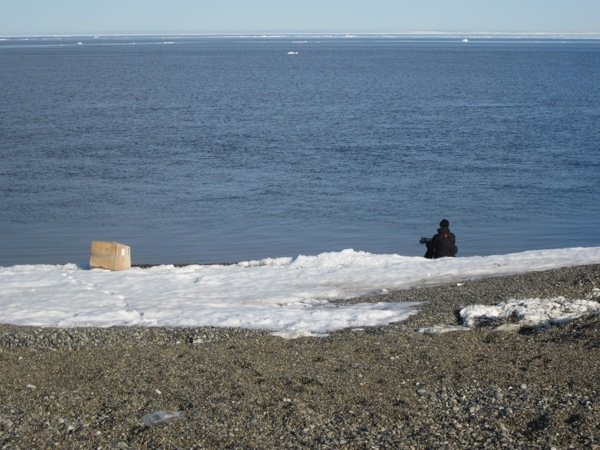Ocean Watch



As I sat on the gravel beach in Gambell, looking at the ocean and watching the stream of Alcids flying by, I thought: this is the best reality TV in the world. I rarely watch TV, unless my Tivoli friends show up wanting to watch a basketball, football or baseball game. Then the TV goes on, someone finds some food, a beer appears. The TV is the center, but not really. Our easy friendship is the center; this makes me ridiculously happy.
This TV watching made me happy in a different way. First of all, the viewing was outside, standing or seated on the gravel (though I do love loafing on my couch with friends). People shuffled around as backs got sore. And, it involved watching something truly beautiful: thousands of birds nearing the northern end of their migration.
For many birds, migration involves following a coastline or waterway. This is one reason living along the Hudson River is fun--birds follow the river north and south. I always look forward to those evenings in spring when the Brant head north, and then in fall when they start south. They create a nice rhythm to the year. Here, those birds that nest in the high Arctic pass the tip of land of St. Lawrence Island in the Bering Sea. Most have made a journey of thousands of miles. Some stop in Gambell, like the Snow Bunting and Lapland Longspur. But most fly by. We were there to see the these intrepid travelers. It was like an Easter Egg hunt, only we didn't have to move.
All I had to do was stare out at the wide water. In the distance: Chukotsk Peninsula, Russia. Ice flows floated north, with speed, telling me the currents offshore are strong. The water was--how to describe the cold? Imagine water made of just-melted ice. The tips of my fingers tingled.
As we stood and watched, a dog would join us, playing with a piece of garbage that drifted down from the dump. Or, chew on a crab found amidst the gravel. At times children would join us, chattering away while we stood and watched the ocean. They didn't speak with us, but with each other, recounting stories as children do.
Identifying birds on the wing isn't easy--something I will never be good at--but after a while I got the hang of some of them--enough that I could tell when something special was coming into view (something special like a yellow-billed loon). The Thick-billed Murres flew in formation, their football shaped black and white bodies distinct. Often they were led by a Horned or Tufted Puffin, visible with those chunky orange bills. The little auklets flew in groups, often low to the water.
So we all counted on our leaders Kevin and David to call out what they saw and be sure to note the special birds.
"Spectacled Eider!" Kevin called and everyone scrambled for the scopes. The birds, a pair, made a quick stop so everyone could admire them. And, of course, some wanted to check these birds off of their life lists.
As I enter this strange and wonderful world of birding I'm always thinking about what it is I enjoy, what compels me. The lists do not excite me, even though I write everything down (this is more a writer's tick). Standing on the shoreline watching birds fly by isn't my idea of good birding--I like to walk along trails, into mountains, and then spend time looking closely at a bird, noting eyes and feathers and the change of color in light. Standing on the shore contemplating migration and watching the stream of birds was fun, though; watching Ocean TV is fun.
In the distance a whale blew, then breached. We all oohed, just like my friends in Tivoli do when the ball is hit out of the ball park.
photos above: VENT Ocean Watch joined by two local boys; Peter Schoenberger waiting to photograph passing birds; Tracy making friends with a local dog.